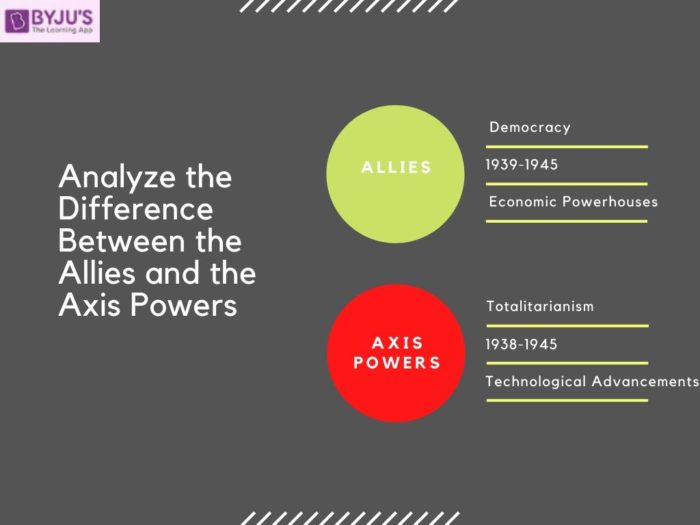With 70 to 85 million casualties, World War 2 was and remains the deadliest conflict known to humankind. It was a global war lasting from 1939 to 1945 involving almost all the nations of the world, eventually forming two opposing military alliances: The Allies and the Axis Powers
The Allies of World War 2 were the countries that fought against the Axis powers during the conflict.
The Axis powers were the nations that fought in World War 2 against the Allies.
You can find more Difference Between Articles, by visiting the linked page

Both had diverging agendas and ideologies that set them apart from each other. The points of divergence will be discussed at length in this article within the context of the IAS Exam
Differences between the Allies and Axis Powers
| Allies |
Axis Power |
| The origins of the Allies stemmed from the wartime alliances made in World War 1. It was also made up of the original members of the defunct League of Nations | The Axis developed through the diplomatic efforts of a resurgent Nazi Germany, Fascist Italy and Imperial Japan. A pact was made between the three to secure their own imperial interests in their respective spheres of influence. |
| The Allies initially consisted of European Nations except Germany, Italy and Russia. Spain, Portugal, Switzerland, and Sweden were neutral. Russia (Soviet Union) and the USA would join later in 1941. | The Axis consisted of Germany, Italy and Japan. But after the German blitzkrieg campaigns of 1939-1940, they were joined by countries occupied directly by them or governments that supported the Axis, such as Bulgaria, Romania, Finland and Norway |
| The Allied camp would be led by US President Franklin D. Roosevelt, British Prime Minister Winston Churchill and Soviet Premier Josef Stalin | The Axis camp was led by German Fuhrer Adolf Hitler, Italian Dictator Benito Mussolini and Japanese Shōwa Emperor Hirohito (Although military affairs were helmed by General Tojo Hideki) |
| The governments of the Allied nation were democratic and liberal in their nature and approach. | The Axis powers were authoritarian regimes led by powerful dictators who championed different forms of fascism, authoritarianism and militarism |
| The main goal of the Allies was to end the conflict and liberate nations under occupation by the Axis powers | The primary goal of the Axis powers was territorial expansion at the cost of its neighbours and defending civilization from communism. |
| The wartime GDP (Gross Domestic Product) of the Allies was $1798 billion, out of which $1094 billion was of the United States | The wartime GDP of the axis was $911 billion at its height in 1941 |
| The Allied population (excluding the Soviet Union and the United States, which later joined the Allies) was 689.7 million in 1938 | The Axis population in 1938 was 258.9 million. |
Axis and Allied Powers are covered extensively under the World History segment of the IAS Exam. Aspirants can refer to the following links to learn more about this segment.
- World History for UPSC Mains
- How to Study and Prepare for History in the UPSC Exams
- UPSC History Syllabus
- United Nations
- Cold War
- Difference Between Democracy and Dictatorship
- Difference Between Fascism and Nazism
Difference Between Allies and Axis Powers – Download PDF Here
Frequently Asked Questions about Allies and Axis
Which were the Allied nations in World War 2?
Which countries remained neutral by not joining the Allied or Axis powers?
Aspirants can become familiar with the general pattern of the IAS exam by visiting the IAS Syllabus page. For more preparation materials, they can refer to the links given in the table below:
Related Links
| NCERT Books | UPSC Exam Pattern | Current Affairs Quiz |
| Current Affairs PDF | World War I | PIB Summary and Analysis |
| Green Revolution in India | Pradhan Mantri Matritva Vandana Yojana | Project Tiger |
Its very good